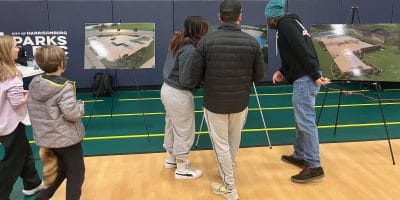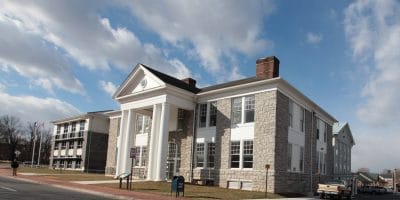
By Randi B. Hagi, assistant editor
The shovels — both ceremonial and actual — have broken ground at the future site of Harrisonburg’s second high school, which is slated to open in fall 2022. But there are still major decisions ahead. How will students be divided between the two schools? How will the district navigate its programming focuses, with one school geared towards STEM and the other towards fine arts? And how will the new school arrive at a new name?
And those are just a few of the biggies. Here’s The Citizen’s guide to what comes next on the road to a new high school:
Labs for the new school, dance studio for the existing one
Maintaining equity for Harrisonburg students has been a prominent theme in community discussions about how the two schools will be distinctive from one another.
The new high school’s design includes state-of-the-art computer labs and other technology to lay a foundation for a strong STEM program.
Superintendent Michael Richards also said the new high school’s design committee cut from the blueprints a large auditorium — one that might have been used for performances and plays — in order to save money.
To bolster the current Harrisonburg High School’s capacity to house a fine arts academy, the school district plans to renovate four classrooms to create a dance studio and a stage lab that includes a dressing room and green room.
During a work session meeting Tuesday, school board members approved a plan that includes that overhaul. All of the Harrisonburg School Board members present voted to adopt a new Capital Improvements Plan, which will act as a guiding document for the next five years worth of expenses that cost more than $50,000. (School board member Kaylene Seigle was absent for the meeting.)
However, the plan’s projects are subject to change. “It’s not a budget, it’s a planning tool,” Craig Mackail, chief operating officer for the schools, said.
Included in that new plan is an anticipated $500,000 for the dance studio and stage lab spaces, although Mackail said they would need to consult with an architect before they really know how much the remodel will cost.
The plan calls for spending half of that money in the 2021-2022 school year, with the hopes of building the dance studio in the summer of 2021. Those renovations would include removing a wall to create one large room, adding ballet barres and wall-length mirrors, and a specialized floor.
J.R. Snow, the schools’ visual and performing arts coordinator, said the dance curriculum has grown to where it’s competing with other programs to use the auditorium for classes.
“If you built that [studio] tomorrow, I could use it tomorrow,” Snow said.
The second half of the $500,000 is intended for the stage lab the following year, after the new high school opens. The two classrooms slated for the stage lab are currently being used for special education, so moving some of those students to the new high school would make that space available.
Newly-elected school board chair Andy Kohen told The Citizen that, while they don’t know when or how high school redistricting will take place, they expect it to look different from any lines they’ve drawn before.
“Every high school student in Harrisonburg will have a home school,” Kohen said, but every student will have opportunities to take specialized classes offered at both schools.
“We will provide transportation to enable those students to do that in as seamless a way as possible,” he said. “So the redistricting is a little different, because of those specific features.”

Solar power
Kohen said that, while the new high school design doesn’t include solar panels, its roof was designed to be “solar-ready” for a future installation.
“Much the same foresight that was used in building Bluestone Elementary,” Kohen said. And photovoltaics for Bluestone may be close to fruition. The school board voted last October to pursue a collaboration with the Harrisonburg Electric Commission, after a planned project with Secure Futures, LLC fell through in July.
“I’m very hopeful that by the spring, we will have in place methodology and perhaps even work to install solar panels, most likely on Bluestone Elementary,” Kohen said.
The city’s responsibilities
The city of Harrisonburg has responsibilities in the schools construction as well – including ultimately paying for the project and making road and utility adjustments to improve access into the site.
City Manager Eric Campbell told The Citizen that staff are currently figuring out “the impact on adjoining properties so that the amount of needed right of way can be determined … the city has begun having discussions with some of the property owners that will be impacted.”
A traffic impact analysis and a land survey for intersection and roadway improvements have already been completed.
City staff have also been working with a financial advisor and bond attorney to issue the bonds necessary to pay for the project. Campbell said that process will proceed along the following timeline:
- The Harrisonburg city council will hold a public hearing to issue the bonds for the roughly $100 million project at its Tuesday, Jan. 28, meeting;
- The council will vote on approving the bond resolution at its Feb. 11 meeting;
- City staff will meet with the credit rating agencies the week of Feb. 24;
- The bonds will be sold the week of Mar. 23;
- And closing on the bonds will happen the week of April 13.

Naming “HHS2”
The school board recently adopted a new naming policy for entire schools and individual school structures, which Kohen described as “more formal” than their previous process. The new policy includes:
- Establishing a committee that could include school staff, parents, students and community members to suggest possible names,
- A method for the public to submit suggestions in writing,
- The suggestion that the naming committee consider geographic and historical names, including deceased people who “significantly contributed to improving life in Harrisonburg City, Harrisonburg City Public Schools, the Commonwealth of Virginia, or the United States of America,” and who died at least five years ago.
Kohen told The Citizen that the school board used similar criteria when naming Bluestone Elementary and the Elon W. Rhodes Early Learning Center, which both opened in 2017. Rhodes was the first African-American city councilman in Harrisonburg, and served on the school board as well as other city commissions. He died in 2006.
“In those cases, we made open requests of the community: what would you like to see these buildings named?” Kohen explained.
Journalism is changing, and that’s why The Citizen is here. We’re independent. We’re local. We pay our contributors, and the money you give goes directly to the reporting. No overhead. No printing costs. Just facts, stories and context. Thanks for your support.












